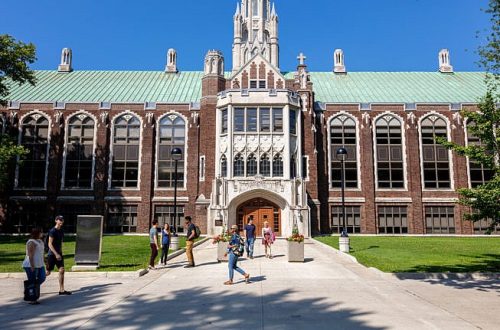How To Get Into The University Of Maryland: Acceptance Rate & Strategies
The University of Maryland-College Park had welcomed 75% of applicants into its Terrapin family before the advent of the new millennium. Since the Clinton Presidency, the University of Maryland accept rate has fallen to just 41%. The number of applicants has nearly doubled. A generation ago, many Maryland freshmen possessed solid-but-unspectacular academic credentials; in 2021, first-year Terrapins sport a median SAT score of 1430 and an average weighted GPA of almost 4.4. It’s that competitive.
In light of the increasing selectivity, this article will help you understand how to apply to the University of Maryland.
- Acceptance rate at University of Maryland College Park
- University of Maryland Early Action Acceptance Rate
- Accepted University of Maryland students are eligible for SAT, GPA, or class rank.
- Trends in admissions
- University of Maryland’s system to rate applicants
- Take a look at current University of Maryland undergraduates.
- The University of Maryland’s acceptance rate (yield): This is the percentage of admitted students who attend University of Maryland.
- Tips to apply to the University of Maryland
- UMD Supplemental Essay Advice
- How do you determine whether the $75 application fees to the University of Maryland are worth it?
Students applying to UMD College Park might also find these blogs useful:
How To Get In:
-
University of Michigan
-
Penn State University
-
George Washington University
Let’s examine the most recent admissions statistics.
University of Maryland Acceptance rate
For the Terrapin Class 2024, there were 50,306 applicants. Only 20,382 of those applicants, or 41%, were admitted to College Park. Maryland does allow in-state applicants to apply for admission but the state doesn’t publish the admission rates. Therefore, we can’t quantify the advantage.
University of Maryland Acceptance Rate
According to most recent data, applying for the University of Maryland’s Early Action round almost constitutes a requirement. The Class 2024 had 59% of EA candidates accepted, and only 18% received Regular Decision applications. An amazing 94% of the class received Early Action acceptances. This cohort received 49% of the total acceptance rates.
University of Maryland Admissions.
Class of 2020 members’ SAT range was between 1340-1490 and ACT range was between 30-34. Furthermore, 85% had a GPA greater than 4.0. Of the 2021-22 enrolled students, 69% were among the top 10% and 90% respectively.
Admissions Notes & Trends
- First, 76% of Maryland’s undergraduates are Marylanders.
- International students are also available from 116 countries.
- In one year, there were approximately 32,000 more applicants than there were jobs.
- 14.3% of freshmen came in with sufficient college credit to allow them to start as sophomores.
- UMD- College Park was, and will continue to be, test-optional during the fall 2022 admissions cycles.
University of Maryland’s Application Rates
University of Maryland only considers three factors "very important" in the admissions process. These are high school course loads, GPA and standard test scores. These are considered "important" in the admissions process. They include class rank, first gen status, essays, recommendations and talent/ability. The following factors should be considered: geographical residency, extracurricular activities/personal qualities and alumni relations.
The university lists additional factors that are taken into consideration during the review process. These factors may be the same as those above but they are not all the same. This gives you a better understanding of how holistic application reviews are done.
Holistic reviews can include:
- Performance progression
- Life experiences from all walks of life
- Gender
- Recognition of exceptional achievements
- Other circumstances
- Socioeconomic status
- Written expression (as displayed in the essay)
- Service to the community
- Demonstrating leadership
- Learning differences
- Education background of the family
- English as a second/home language
Straight from UMD’s admissions office: "The undergraduate application process is rigorously individualized. The university must be able to evaluate all the information in an application consistently, as it has to make distinctions between a large number of highly qualified applicants. The university uses a holistic review process to assess all applicants. Professional educators use their expertise to judge each applicant’s qualifications and build an entering class that best meets the university’s mission.
Recruite athletes have a distinct advantage. Maryland prides itself on its 19 NCAA Division I sports teams. The university currently has more than 700 student athletes. Finally, our blog How many extracurricular activities do I need for college provides advice on how you can stand out.
Students’ Characteristics at University of Maryland
Let’s look at the student population of the University of Maryland.
The top ten states sending the most students for UMD include:
- Maryland
- New Jersey
- New York
- Pennsylvania
- Virginia
These states are home to the fewest number of students.
- Montana
- Wyoming
- North Dakota
- South Dakota
- Alaska
The following countries host the largest international students:
- China
- India
- South Korea
- Taiwan
- Canada
This is how ethnic identity is broken down:
- White: 47%
- Asian: 19%
- Hispanic: 10%
- African Americans make up 12% of the population
- Two or more races: 5%
- International: 4%
The gender split shows that more women are enrolled in university than men.
- Men: 52%
- Women: 48%
University of Maryland’s Yield Rate
The yield rate at University of Maryland is 27%. This means that 27% of the accepted students enrolled. This number is lower than that of other state universities such as the University of Florida (47%) and University of Michigan (45%), and UVA (43%).
Tips to Apply to University of Maryland
You should be aware of these things if your goal is to join the 32,000+ University of Maryland candidates for the next cycle of admissions.
- FIRST, please apply before November 1. In case you’re skimming, this one is in all caps.
- University of Maryland has no interviews in its evaluation process.
- Furthermore, the University of Maryland does NOT consider "demonstrated Interest" so it is not relevant to whether you made campus visits, contacted admissions officers, etc.
- Prospective Terrapins may apply via the Common Application and Coalition Application.
- The preferred major that you choose is not considered in general admissions decisions. Because there is limited space, applicants who are majors that have "Limited Eligibility Programs" will need to be subject to additional scrutiny by the department. Click here to view a complete listing of LEPs.
- Make sure you give enough attention to the University of Maryland’s "Complete This Sentence", which requires short responses. These are the 2021-22 cycles.
Students at the University of Maryland are encouraged to explore opportunities outside of the classroom.
Let us know more about you using the space provided (160 character limit).
-
I would travel to …* if I could.
-
The best fact I discovered from my research was …*
-
I am interested in …* as well as my major.
-
Last Monday’s best memory was …*
-
You might not know …*
Should You Apply to University of Maryland
Those who score between mid-50% and high 50% on the SAT/ACT are considered viable candidates to this exceptional institution. According to the school, freshman students are required to have strong A/B+ averages in high school coursework. They also need to be enrolled in challenging courses such as honors and Advanced Placement.
It’s obvious that teens who apply to schools of the University of Maryland must also include a mixture of safety and target schools in their college list. Find out more about creating a balanced list of colleges here.



